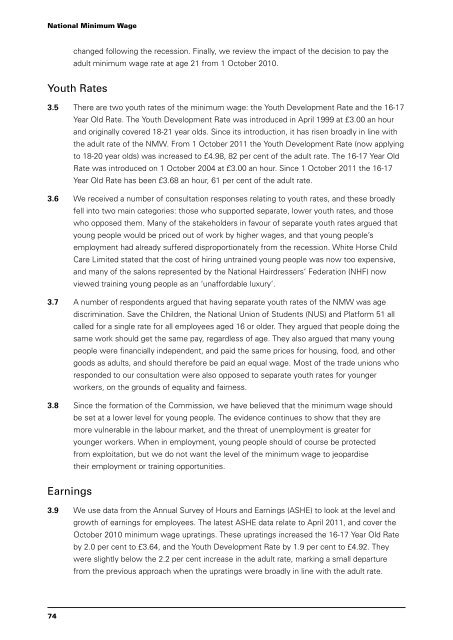National Minimum Wage
National Minimum Wage
National Minimum Wage
Create successful ePaper yourself
Turn your PDF publications into a flip-book with our unique Google optimized e-Paper software.
<strong>National</strong> <strong>Minimum</strong> <strong>Wage</strong><br />
74<br />
changed following the recession. Finally, we review the impact of the decision to pay the<br />
adult minimum wage rate at age 21 from 1 October 2010.<br />
Youth Rates<br />
3.5 There are two youth rates of the minimum wage: the Youth Development Rate and the 16-17<br />
Year Old Rate. The Youth Development Rate was introduced in April 1999 at £3.00 an hour<br />
and originally covered 18-21 year olds. Since its introduction, it has risen broadly in line with<br />
the adult rate of the NMW. From 1 October 2011 the Youth Development Rate (now applying<br />
to 18-20 year olds) was increased to £4.98, 82 per cent of the adult rate. The 16-17 Year Old<br />
Rate was introduced on 1 October 2004 at £3.00 an hour. Since 1 October 2011 the 16-17<br />
Year Old Rate has been £3.68 an hour, 61 per cent of the adult rate.<br />
3.6 We received a number of consultation responses relating to youth rates, and these broadly<br />
fell into two main categories: those who supported separate, lower youth rates, and those<br />
who opposed them. Many of the stakeholders in favour of separate youth rates argued that<br />
young people would be priced out of work by higher wages, and that young people’s<br />
employment had already suffered disproportionately from the recession. White Horse Child<br />
Care Limited stated that the cost of hiring untrained young people was now too expensive,<br />
and many of the salons represented by the <strong>National</strong> Hairdressers’ Federation (NHF) now<br />
viewed training young people as an ‘unaffordable luxury’.<br />
3.7 A number of respondents argued that having separate youth rates of the NMW was age<br />
discrimination. Save the Children, the <strong>National</strong> Union of Students (NUS) and Platform 51 all<br />
called for a single rate for all employees aged 16 or older. They argued that people doing the<br />
same work should get the same pay, regardless of age. They also argued that many young<br />
people were financially independent, and paid the same prices for housing, food, and other<br />
goods as adults, and should therefore be paid an equal wage. Most of the trade unions who<br />
responded to our consultation were also opposed to separate youth rates for younger<br />
workers, on the grounds of equality and fairness.<br />
3.8 Since the formation of the Commission, we have believed that the minimum wage should<br />
be set at a lower level for young people. The evidence continues to show that they are<br />
more vulnerable in the labour market, and the threat of unemployment is greater for<br />
younger workers. When in employment, young people should of course be protected<br />
from exploitation, but we do not want the level of the minimum wage to jeopardise<br />
their employment or training opportunities.<br />
Earnings<br />
3.9 We use data from the Annual Survey of Hours and Earnings (ASHE) to look at the level and<br />
growth of earnings for employees. The latest ASHE data relate to April 2011, and cover the<br />
October 2010 minimum wage upratings. These upratings increased the 16-17 Year Old Rate<br />
by 2.0 per cent to £3.64, and the Youth Development Rate by 1.9 per cent to £4.92. They<br />
were slightly below the 2.2 per cent increase in the adult rate, marking a small departure<br />
from the previous approach when the upratings were broadly in line with the adult rate.


